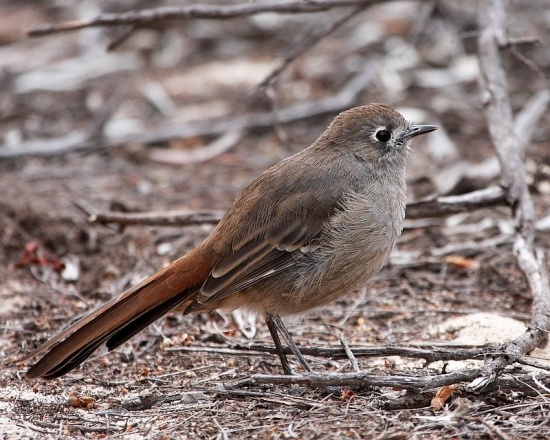(Clearer image. Some copied text disguised. All sections now started. References. Incomplete gone) |
m |
||
| Line 34: | Line 34: | ||
==External Links== | ==External Links== | ||
{{GSearch|Drymodes+brunneopygia}} | {{GSearch|Drymodes+brunneopygia}} | ||
| − | + | ||
[[Category:Birds]] [[Category:Drymodes]] | [[Category:Birds]] [[Category:Drymodes]] | ||
Revision as of 20:47, 12 February 2017
- Drymodes brunneopygia
Identification
18·5–22 cm (7¼-8¾ in)
- Dull grey-brown head and upperparts
- Pale brown throat and underparts
- Lighter belly
- Bright rufous tail with a narrow white tip
- White tipped wing coverts forming a double bar on the wing
- Large dark eye with pale rear eye-ring and vertical black eye mark
- Black beak and legs
Sexes are alike with the female being distinctly smaller.
Juveniles are described as similar to adults with darker plumage and streaked juvenile wing coverts.
Distribution
Southern Australia (Shark Bay, Western Australia to western and central New South Wales)
Taxonomy
This is a monotypic species[1].
Habitat
Mallee and acacia scrub, broombush and other dry shrubs.
Behaviour
Diet
They feed on the ground searching for small invertebrates, especially certain ant species. They also sometimes look for seeds.
Breeding
Monogamous. They construct a shallow cup-shaped nest of twigs, bark and grass,which is placed on the ground.
The male feeds the female during courting.
References
- Clements, J. F., T. S. Schulenberg, M. J. Iliff, D. Roberson, T. A. Fredericks, B. L. Sullivan, and C. L. Wood. 2016. The eBird/Clements checklist of birds of the world: v2016, with updates to August 2016. Downloaded from http://www.birds.cornell.edu/clementschecklist/download/
- Handbook of the Birds of the World Alive (retrieved October 2016)
Recommended Citation
- BirdForum Opus contributors. (2024) Southern Scrub Robin. In: BirdForum, the forum for wild birds and birding. Retrieved 19 April 2024 from https://www.birdforum.net/opus/Southern_Scrub_Robin




